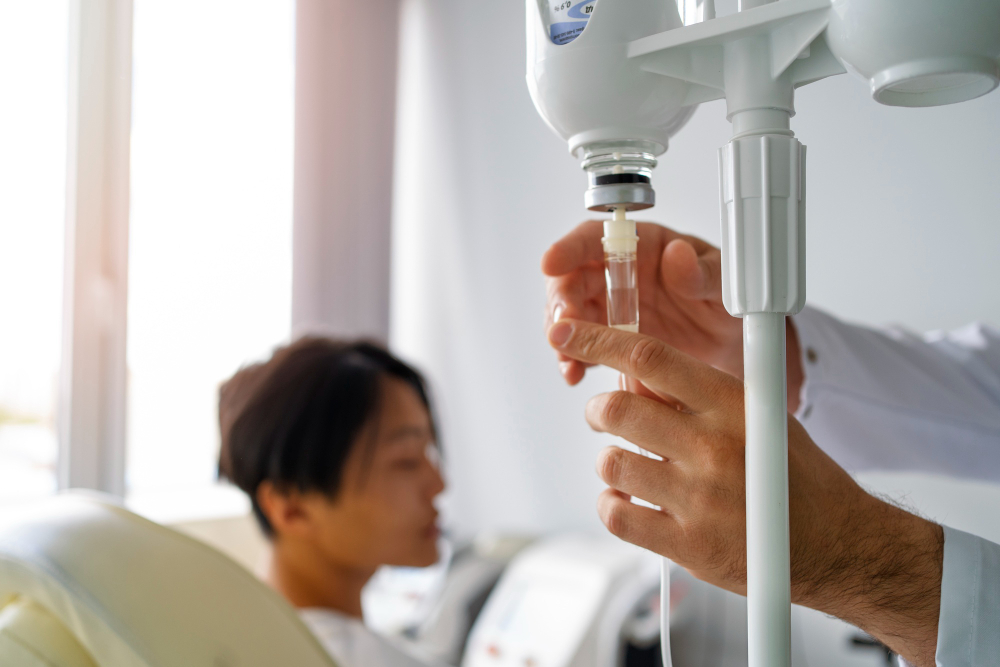IV Therapy

Intravenous (IV) therapy is a form of therapy that delivers fluids directly into a person's vein. It is commonly used for rehydration or to provide nutrition for those who cannot consume food or water by mouth.
Additionally, it can be utilized to offer therapeutic treatments, blood transfusions, and pharmaceutical administration.
In order to administer IV therapy, a catheter must be inserted into a vein, usually in the arm or hand. The catheter's other end must then be connected to a line of tubing. Fluids can then be infused directly into your bloodstream through this tubing.
Common Uses of IV Therapy
IV therapy is a fundamental part of medical treatment with numerous applications. It allows healthcare providers to introduce fluids, medication, and nutrients directly into a patient's bloodstream.
Here are some common uses of IV therapy:
- Fluid Replacement: To treat dehydration or prevent it during severe illness, fluid loss after injury or burns, and during surgery.
- Delivery of Medications: IV is commonly used for the direct administration of medications. This method is especially useful when a quick response is required or when the medication is too irritating to be administered orally or by other routes.
- Blood Transfusions: IV therapy is essential during blood transfusions, where blood or blood components are transferred directly into the bloodstream.
- Nutritional Therapy: For patients who can't eat or absorb nutrients through the gastrointestinal system, total parenteral nutrition (TPN) can be provided via IV.
- Anesthesia: IV therapy is often used to administer anesthetics during surgical procedures.
- Correction of Electrolyte Imbalances: Electrolyte abnormalities in the body can be deadly; however, IV treatment can swiftly restore them.
- Diagnostic Purposes: Some diagnostic tests may require IV contrast agents, such as during certain radiological imaging studies.
- Immunoglobulin Therapy: For conditions where immune system support is needed, immunoglobulins can be supplied via IV.
- Rehydration After Exercise: In some cases, athletes use IV therapy for rapid rehydration after intense workouts or events, though this is generally only recommended under medical supervision.
- Detoxification: In certain medical detoxification processes, IV therapy may be used to administer medications and maintain hydration.

The procedure for administering IV therapy typically involves the following steps:
- Preparation: The healthcare provider first prepares the required materials. These usually include an IV catheter, IV tubings and bag, gloves, cleaning wipes, a tourniquet, and sometimes a local anesthetic.
- Vein Selection & Access: The healthcare provider puts on gloves, applies a tourniquet around the patient's upper arm to make the veins more prominent, and cleans the skin over the chosen vein.
- Confirmation of IV Placement: After inserting the needle into the vein, the healthcare provider looks for a "flash" of blood in the IV catheter, indicating that the needle is in the vein. The needle is then further advanced and the plastic catheter is pushed over the needle into the vein.
- Securing the IV: The catheter is secured with a dressing to prevent movement and protect the insertion site.
- Administering the IV Therapy: The IV tubing is then connected to the catheter, and the other end is connected to the IV bag. The healthcare provider uses a clamp on the tubing to control the rate at which the medication enters the patient's bloodstream.
- Monitoring: Once the IV is running, the healthcare provider periodically checks the IV site for any signs of complications like inflammation, infiltration, or infection, and also monitors the patient's response to the therapy.
- Removal: The medical professional will remove the catheter from the vein after the therapy is complete and bandage the area to stop bleeding.

Although intravenous (IV) therapy can be a crucial tool in healthcare, it is not without dangers and potential side effects These may range from minor discomfort to more serious complications.
Below mentioned are some of the risks and side effects associated with IV therapy.
- Infection: This is one of the most serious risks associated with IV therapy. It can occur at the site where the needle enters the skin or in the bloodstream. Infections can cause redness, swelling, and pus formation at the site.
- Phlebitis: This is inflammation of the vein into which the IV line is inserted. Symptoms can include redness, swelling, and pain around the IV site.
- Infiltration: This happens when the IV fluid leaks into the tissue surrounding the vein. It can cause swelling, and pain, and can potentially lead to tissue damage
- Extravasation: This is a more serious form of infiltration where the fluid leaking into the surrounding tissue is a medication that can cause damage to the tissue.
- Air Embolism: This is a rare but serious complication where the air gets into the bloodstream. Chest discomfort, low blood pressure, and even potentially fatal problems might result from this.
- Bleeding: Bleeding can occur at the insertion site, particularly in patients with clotting disorders or those taking blood-thinning medications.
- Overhydration: It is possible to get overhydrated if too much fluid is given too rapidly. Overhydration can result in headaches, high blood pressure, and, in more extreme cases, heart failure or fluid in the lungs.
- Allergic Reactions: Allergic reactions to the medication being administered can occur. This may cause a rash, irritation, breathing problems, and in extreme circumstances, anaphylaxis.
- Vein Damage: Frequent or improper insertion of the IV can lead to vein damage.
- Thrombophlebitis: This is a blood clot in the vein that can be caused by inflammation, trauma, or irritation from medications delivered by IV.

When to Reach Out to Us?
If you are experiencing any of the following symptoms, get in touch with us for IV therapy.
- Dehydration: Vomiting, diarrhea, or a lack of fluid intake can cause dehydration. IV therapy can help to rehydrate you and prevent further complications.
- Nutritional Deficiencies: IV treatment can help you acquire the nutrients you need if your diet isn't giving you enough of them. People who are recovering from surgery, those with chronic conditions, and expectant women can all benefit from this.
- Pain Management: IV therapy can be used to deliver pain medication directly into your bloodstream. For those who are in tremendous discomfort due to a medical condition like cancer or surgery, this can be useful.
- Immune Support: IV therapy can help to boost your immune system and fight off infection.

